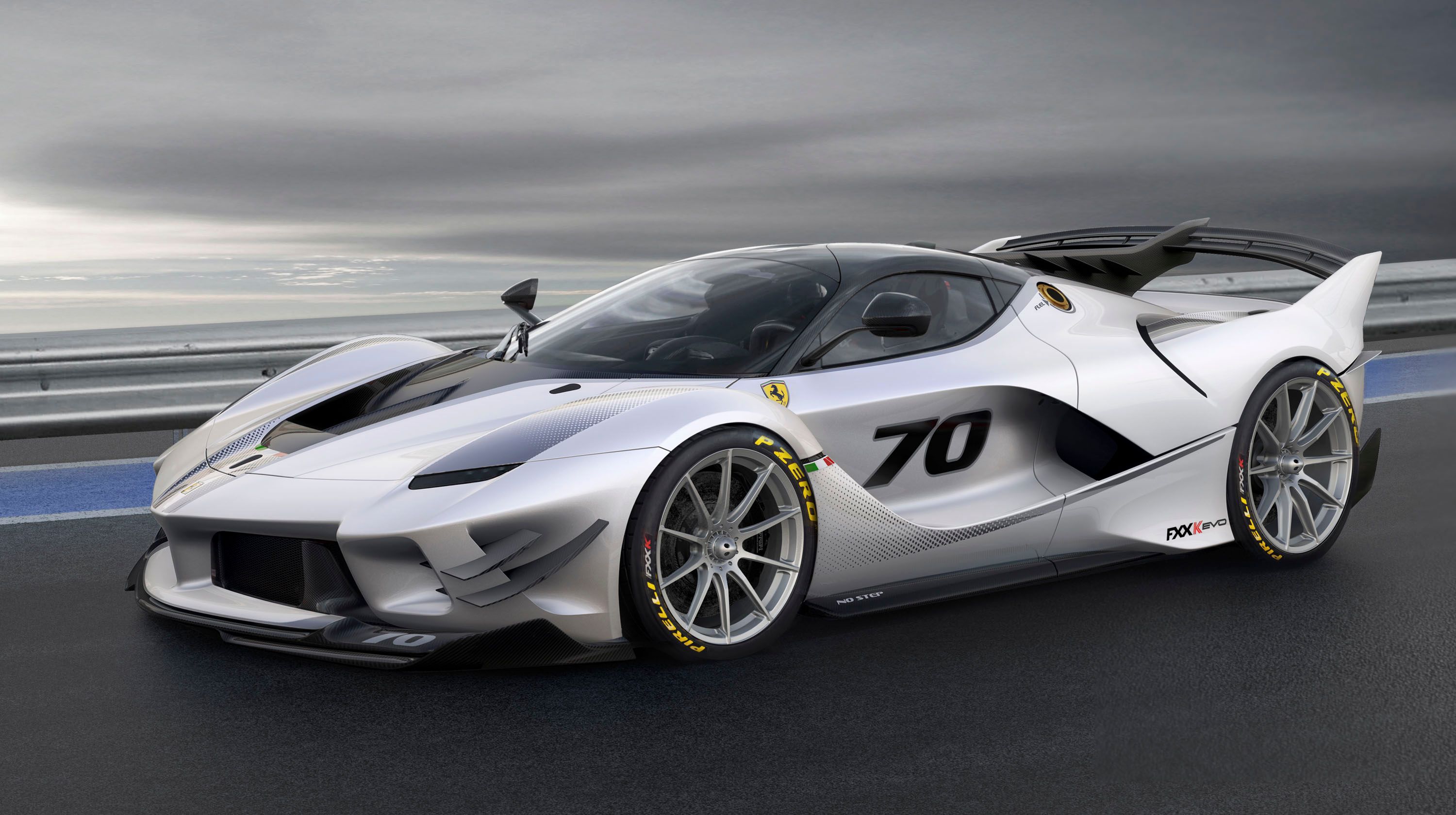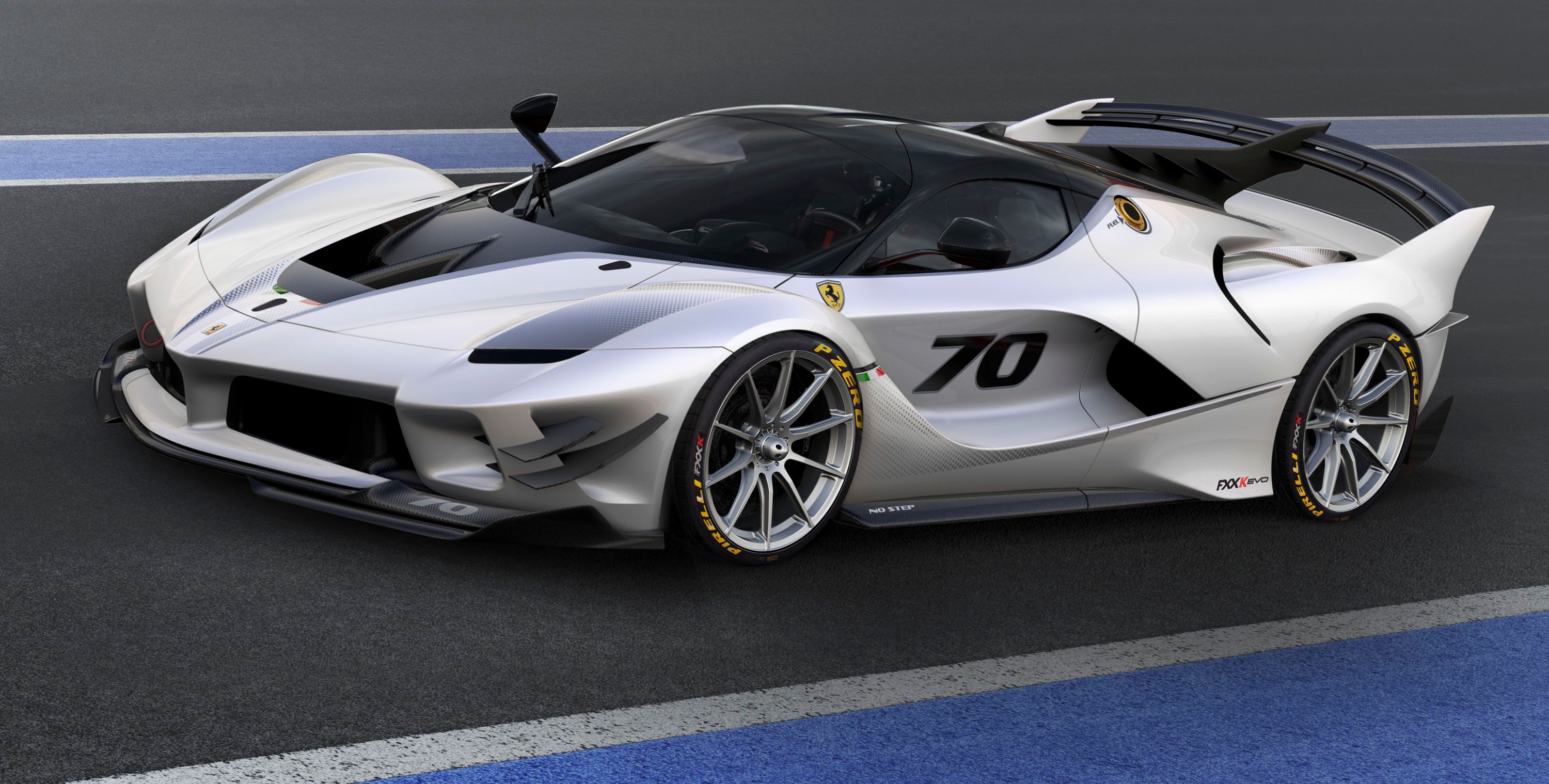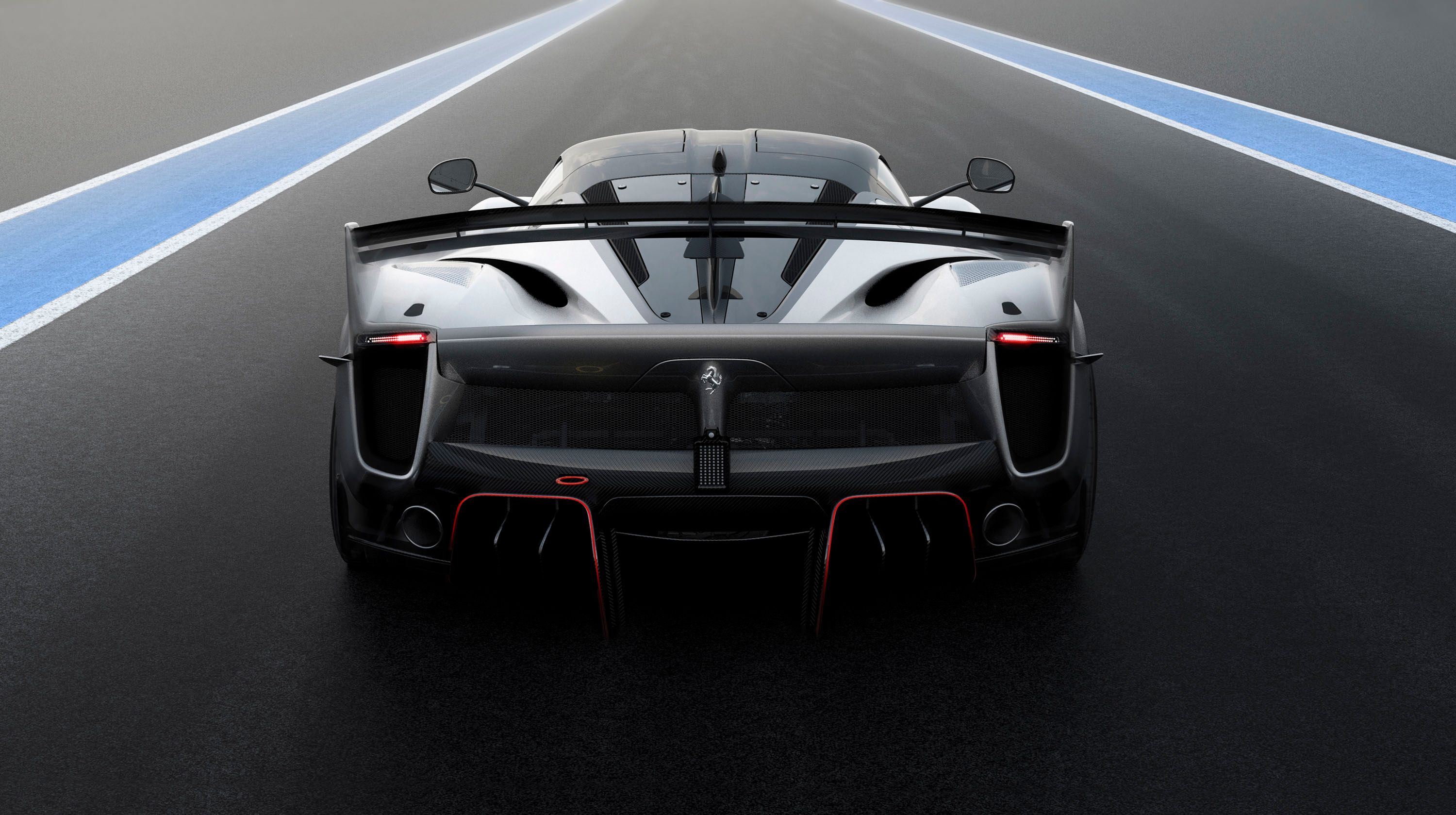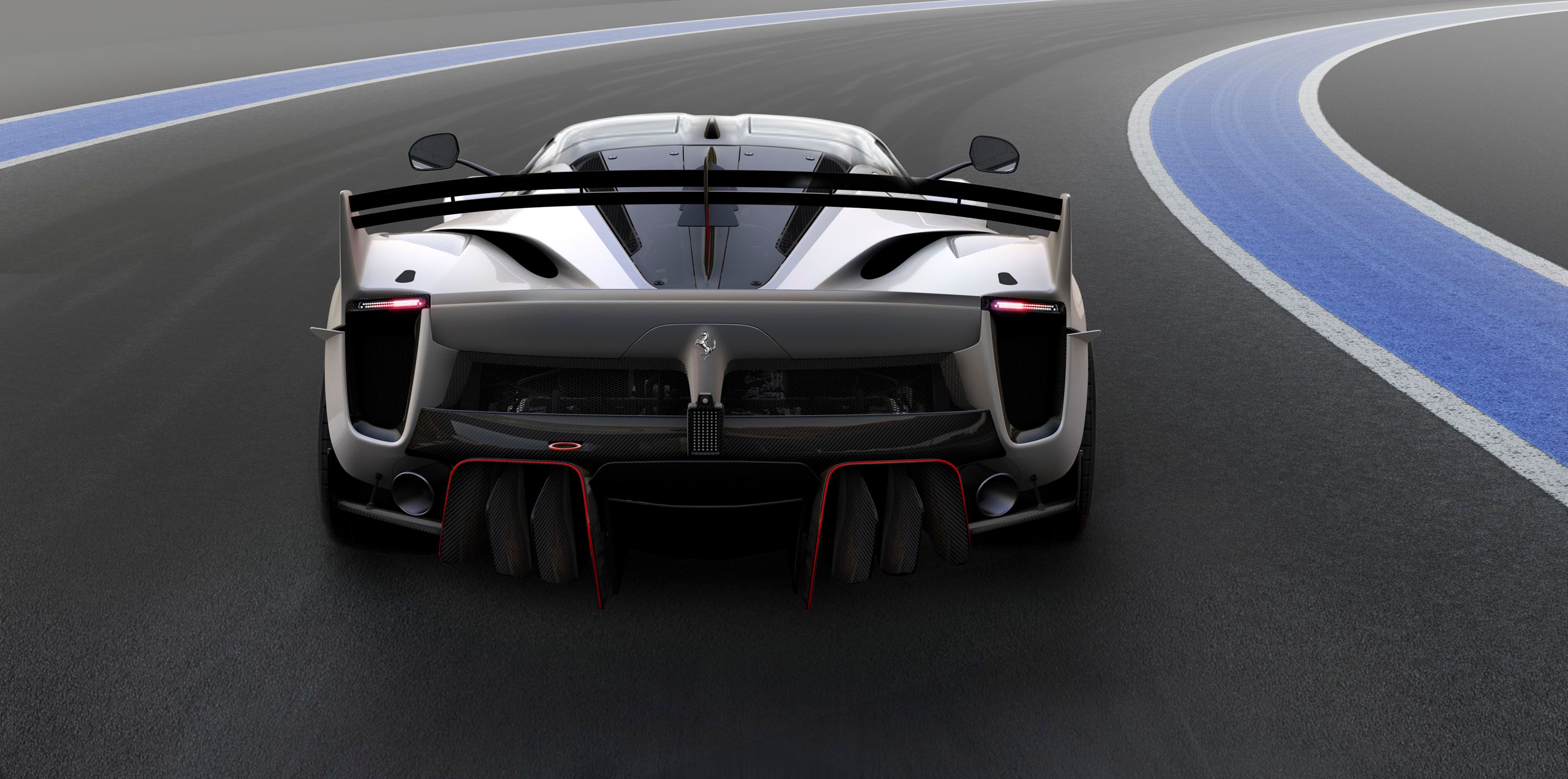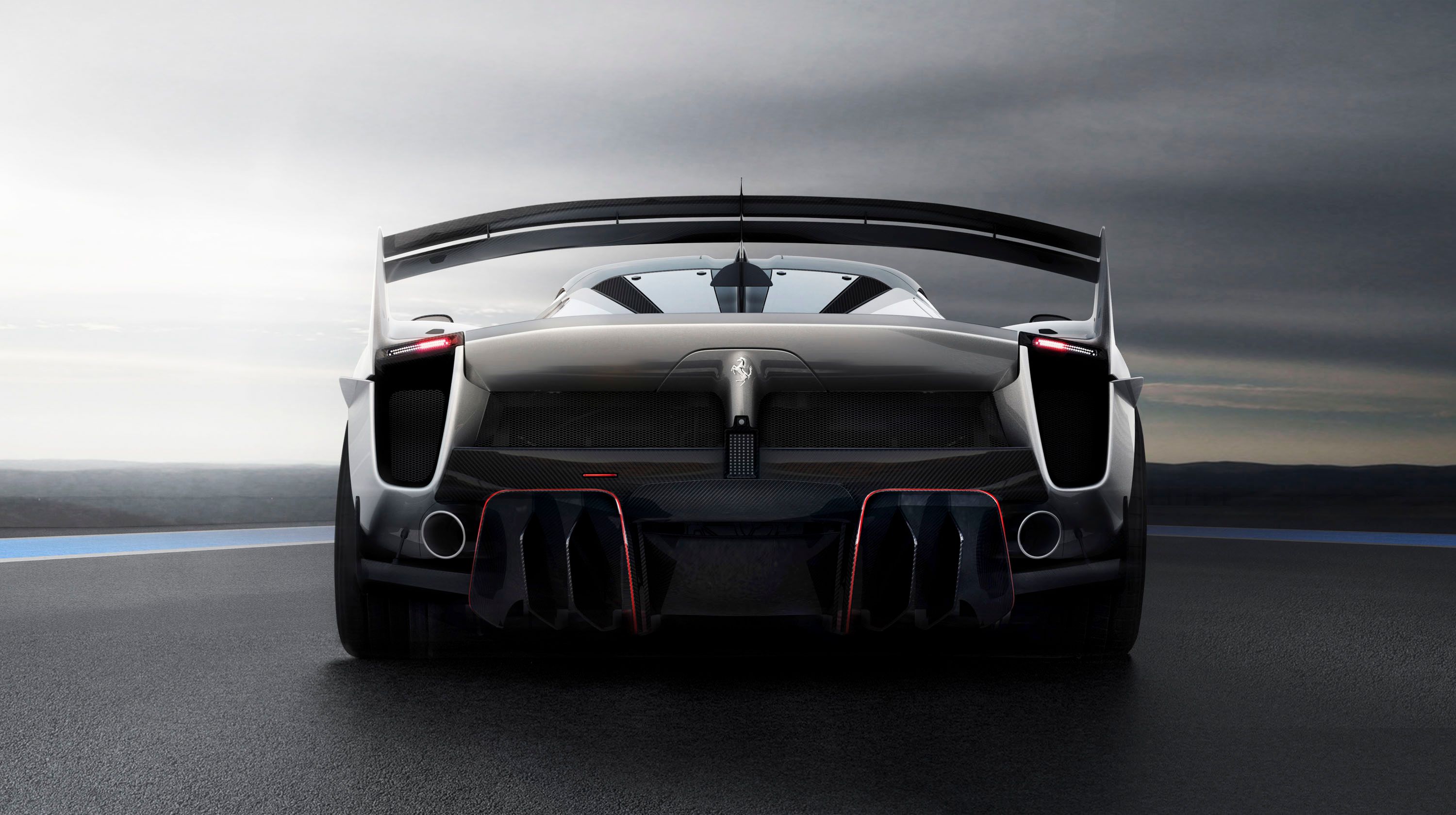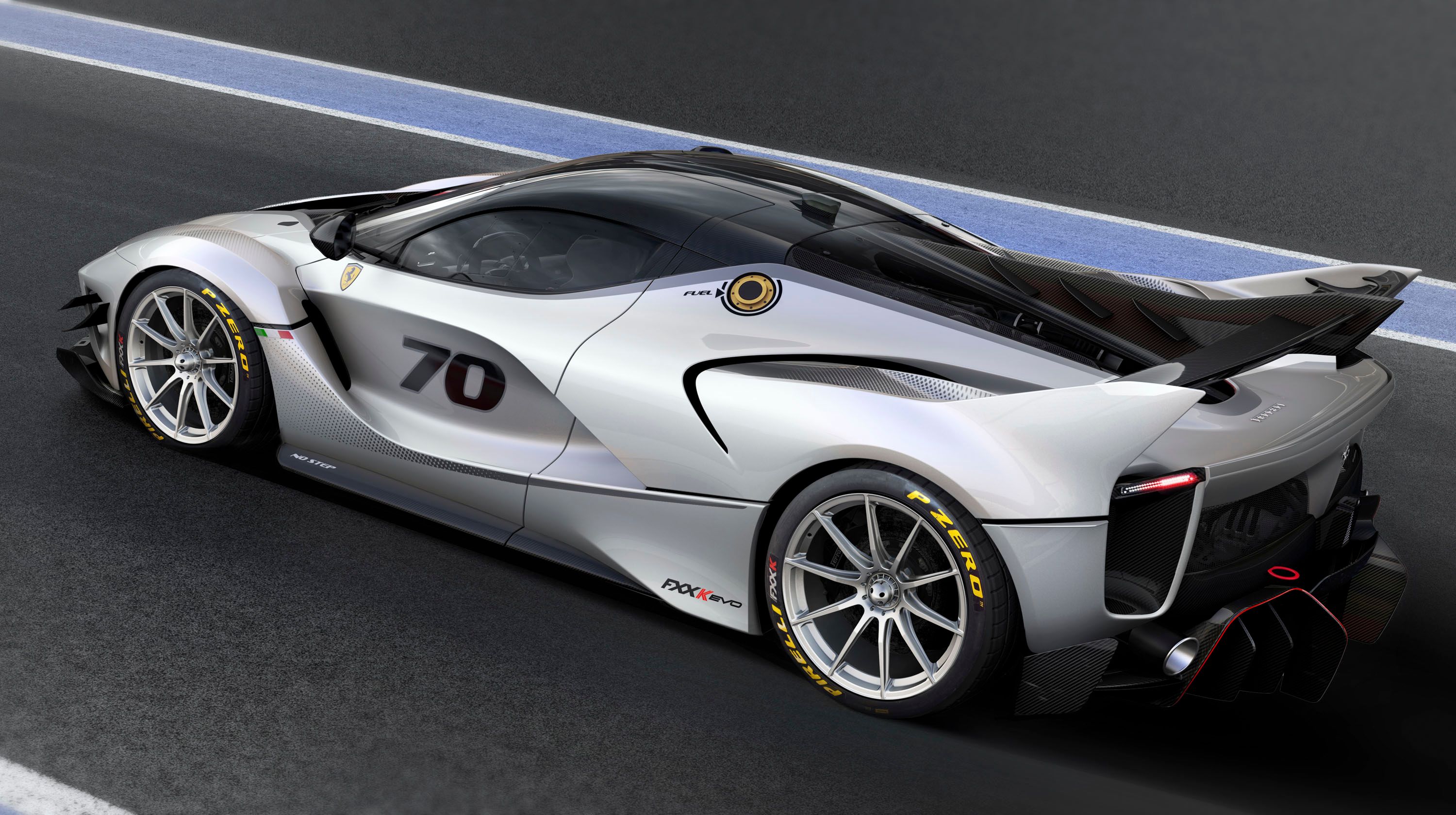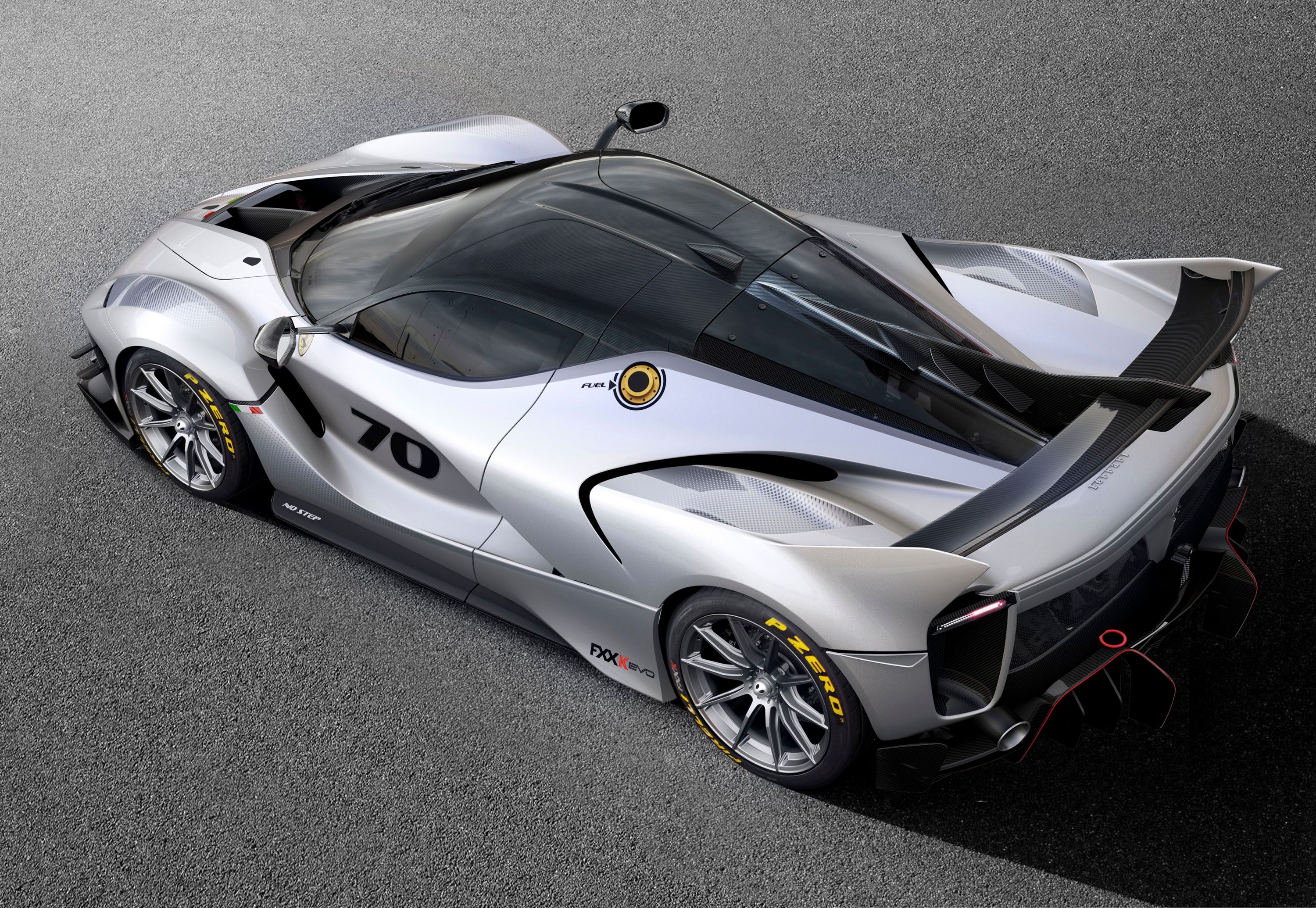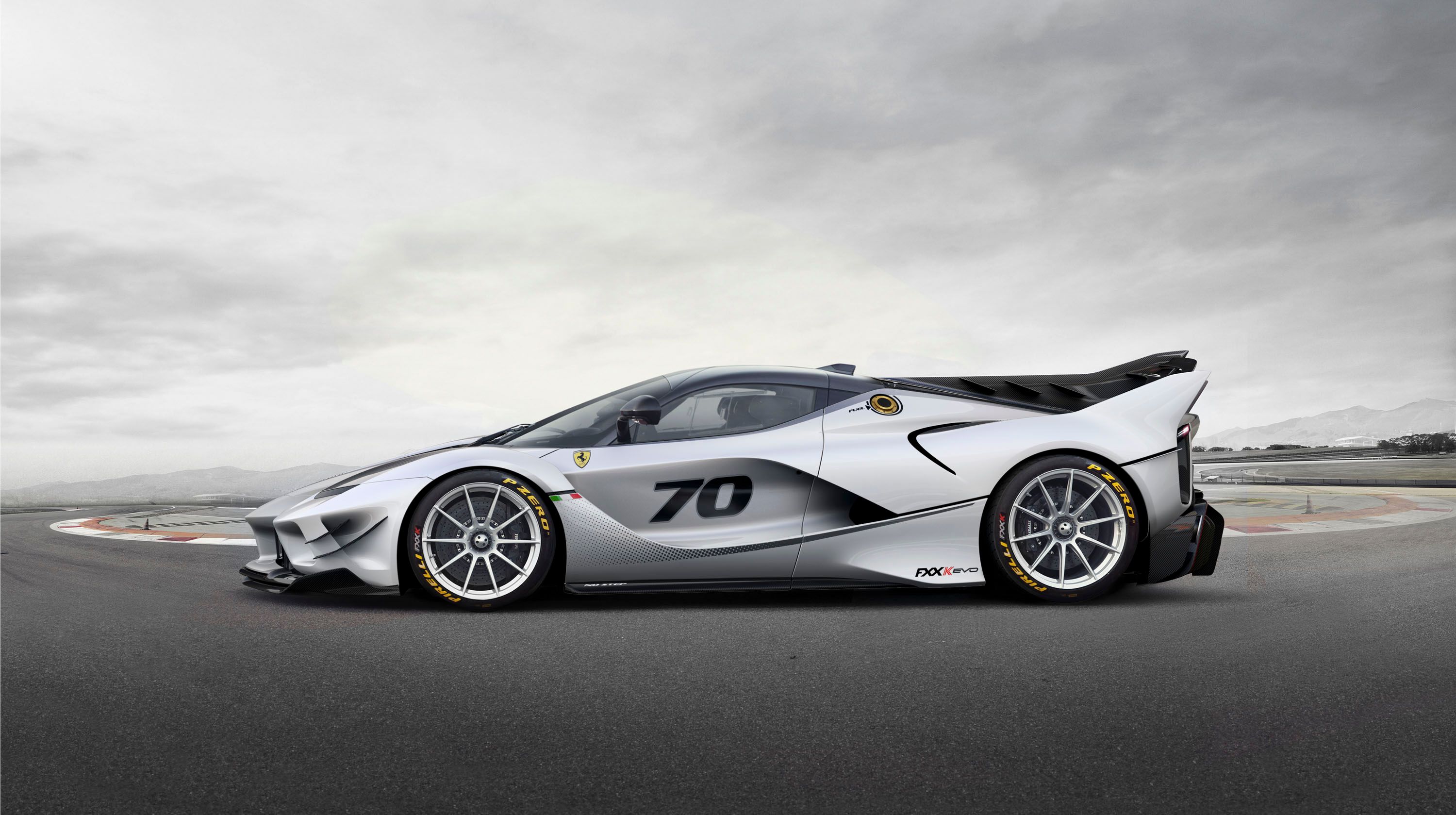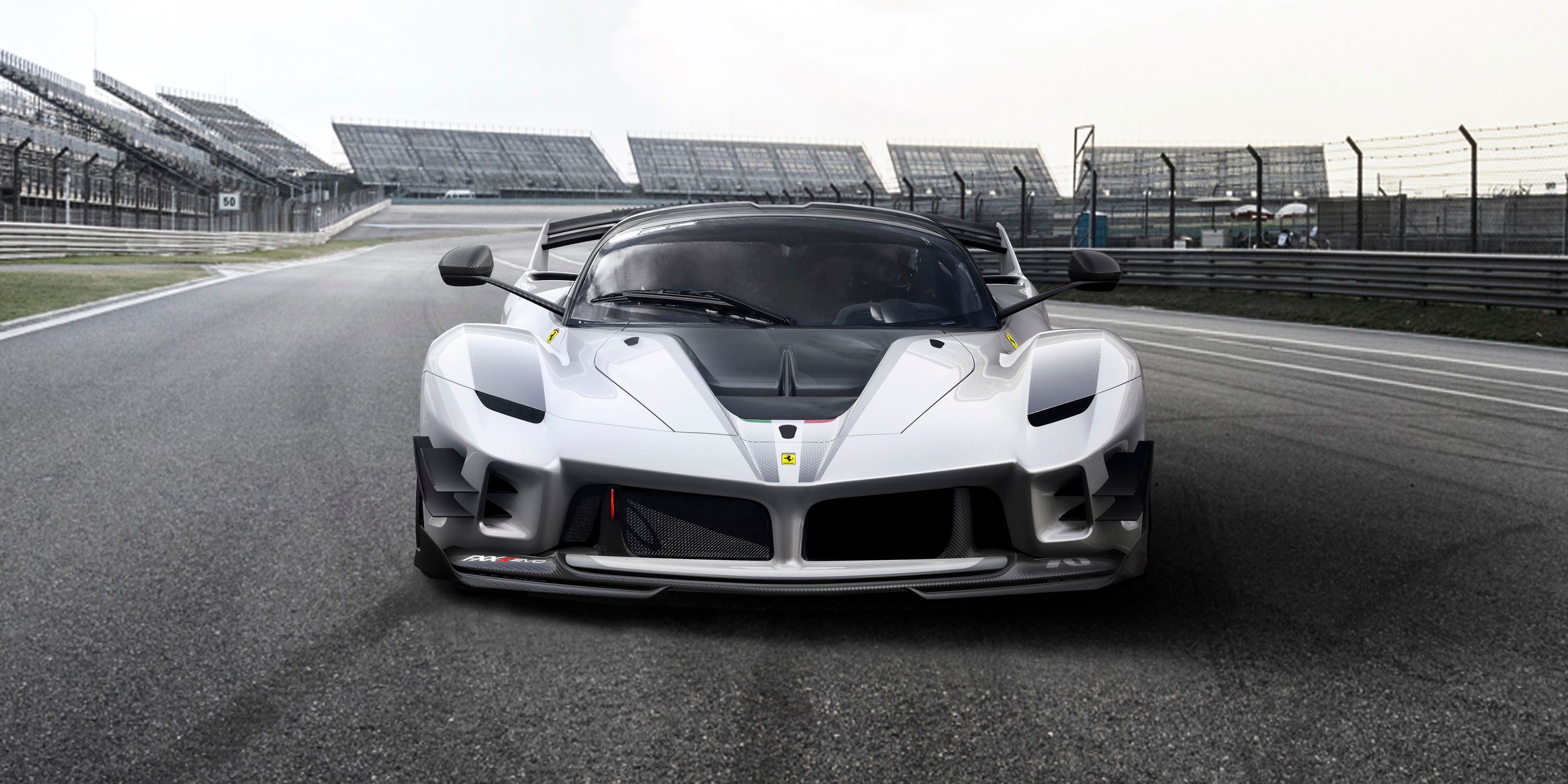When a high-profile carmaker such as Ferrari launches a great supercar like the LaFerrari, it's difficult to imagine a way to significantly improve the design. But the team from Maranello has already done it twice. First, Ferrari launched the FXX-K, a track-only LaFerrari with enhanced aerodynamics. This happened back in 2015. Two years have passed, and the Prancing Horse found a way to make the FXX-K even more brutal. It's called the FXX-K Evo, and it has more downforce than any Ferrari to date!
Launched at the 2017 Finali Mondiale of the Ferrari Challenge, the FXX-K Evo takes the familiar FXX-K to a new level in the same way that the Enzo-based FXX Evoluzione was a heavily upgraded FXX. Just like the FXX-K, the Evo is not homologated for road use, and production will be limited to only a few models. However, the Evo is also available as an upgrade to the standard FXX-K. The package includes many add-ons, starting with an aerodynamic kit built upon know-how obtained from the many racing series Ferrari competes in, including Formula One, GT3, GTE, and Challenge. It's also lighter due to increased use of carbon-fiber and despite having a much larger rear wing. Yes, the FXX-K is a monster of a LaFerrari so keep reading my full review to find out more.
Continue reading to learn more about the Ferrari FXX-K Evo.
2018 Ferrari FXX-K Evo
- Make: Array
- Model: 2018 Ferrari FXX-K Evo
- Engine/Motor: V12
- Horsepower: 1036
- Torque: 664
- Transmission: seven-speed, F1 dual-clutch
- [do not use] Vehicle Model: Array
Exterior
Much like any evolution of an existing design, the FXX-K Evo retains most of the design cues of the FXX-K and the LaFerrari. But the significantly redesigned aero package adds quite a few new features front and rear. The aerodynamics were modification after one year of simulations and wind tunnel testing, with Ferrari claiming that the car now boasts downforce figures that are very close to GT3 and GTE cars. Specifically, downforce improved by a whopping 23 percent over FXX K and an incredible 75 percent over the standard LaFerrari. In exact figures, the Evo generates 1,411 pounds at 124 mph, and exceeds 1,829 pounds at the car’s red-line speed. So this package basically pushes an already amazing car to the very limit.
There aero enhancements modify the FXX-K's appearance a lot, starting with a more menacing front end. The geometry of the sides of the front bumper was altered by hollowing out the surfaces beneath the headlamps, as well as by adding couple of flicks divided by a vertical turning vane. There's also an additional intake ahead of the front wheels. All these elements contribute to a 10-percent downforce gain over the standard FXX-K. Ground effects were also boosted by new vortex generators in the undertray.
There aren't many visual changes to talk about onto the sides, but Ferrari added enlarged rear wheel arch vents. Also part of the package design to make the car more aerodynamic, these improved flow to the rear diffuser, which results in a five-percent downforce boost.
Bigger changes are noticeable around the back. The main highlight is obviously the fixed rear wing. Whereas the FXX-K has those weird horizontal elements glues to the side fins, the Evo badge brought a proper wing to the supercar. But it's by no means a regular wing. The element has a twin-profile design and a big central fin similar to those seen on prototype Le Mans cars. The central fin acts as a vertical fin, boosting stability at low yaw angles, but ut also supports the three triangular vortex generators. The latter clean the flow field striking the wing of the effects of the hot air coming from the radiators which vent onto the engine hood. Additionally, they create a downwash component in the flow which boosts the wings downforce capacity, resulting in a 10-percent increase over the regular FXX-K.
The wing also works in conjunction with the active spoiler, which had its control logics and range of movement reviewed and reprogrammed for optimized results. Below the wing, we can see a revised center fascia that include one instead of two vertical slats above the diffuser. In addition to the huge side vents, Ferrari also redesigned the diffuser, adding wings on each side and red accents on the main elements.
Interior
Note: Standard Ferrari FXX K pictured here.
Ferrari has yet to publish any images of the interior as of this writing, but it's safe to assume that changes compared to the standard FXX-K are slim. The Italians actually mention a new steering wheel that's "brilliantly suited to hugely powerful performance levels achievable in the FXX-K Evo." It has a Formula 1 design with integrated gear-shifting paddles and sports the KERS Manettino for improved ergonomics. The rear camera display to the right of the driver has been replaced with a larger 6.5-inch unit that also displays data from a new telemetry system. The new display includes clearer, more direct performance parameter and car status readouts.
Other than that, look for the usual FXX-K specs, which translates into a rather spartan configuration when compared to the LaFerrari. The Italians ditched all the luxury and convenience features of the road car and replaced them with race-spec, lightweight components. Highlights include a new center console and carbon-fiber inserts instead of soft-touch surfaces on the dashboard. The door panels are also plain carbon-fiber boards, like on any high-performance car.
The seats feature massive bolstering on the sides, a carbon structure and race-spec harnesses. The instrument cluster is also different than the LaFerrari's, featuring new graphics and new display options, allowing the driver to monitor vital car data while on the track.
Drivetrain
The FXX-K Evo uses the same hybrid drivetrain as the regular FXX-K model. The combo brings together a 6.3-liter V-12 gasoline engine rated at 848 horsepower and an electric motor that packs 187 horses. Total output sits at 1,036 horsepower, while torque is rated at an equally impressive 664 pound-feet. For reference, that's an extra 86 horsepower compared to the LaFerrari. The FXX-K Evo also uses the same seven-speed, F1 dual-clutch transmission.
But while the engine remained unchanged, Ferrari had to adjust the suspension to the car's new aerodynamic efficiency figures. It also improved stopping power by redesigning the front brake air intakes for enhanced cooling.
There's no word on performance, but the enhanced downforce and lighter curb weight should make it quicker in certain situations. While it likely won't be quicker than the regular FXX-K from 0 to 60 mph (2.6 seconds), it should lap Ferrari's Fiorano test track faster. With the FXX-K having completed the course in 1.14 minutes, five seconds than the standard LaFerrari, the FXX-K Evo should need around 1.13 minute to do the same.
So who light is the new Evo? Again, no information from Ferrari. But we do know that the FXX-K is some 198 pounds lighter than the LaFerrari, tipping the scales at around 2,767 pounds. The Evo should weigh in at a little less than 2,700, which might not sound like much, but it's a great achievement given that is sports that massive wing and fin at the back.
Prices
Talking about pricing for limited-edition supercar like these is mostly about speculating as automakers rarely announce an official sticker. Just look at the standard FXX K. It was revealed back in 2015 and there's no official price tag to talk about, although word has it that each owner paid at least $3 million to get one. Well, not as much as to buy it but borrow, because all 40 units remained with Ferrari for storage and maintenance, and the drivers only got them for specific events.
This is exactly what will happen with the FXX-K Evo, which will benefit from a very active XX Programme schedule in the 2018/2019 season, with nine track outings between early March and late October. Ferrari didn't say how many car will be built and how many packages will be offered for upgrades, but I have a hunch that the Evo will be at least as exclusive, if not more, than the first FXX-K. So don't expect more than 40 cars/upgrade packages.
Naturally, it will be more expensive than the FXX-K, likely close to $4 million, or even more than that if the limited edition includes significantly less models. Obviously, the cars should cost more than the upgrade, but we won't get any specific figures any time soon. If there's one thing I'm sure of, is that the FXX-K Evo is probably already sold out.
Competition
McLaren P1 GTR
Also based on a road-legal hybrid supercar, the P1 GTR was designed in a similar way. It has an aerodynamically enhanced body with a host of race-spec add-ons, plus a massive wing at the back. The track-focused interior is loaded with carbon-fiber and features a spartan center console holding buttons and switches, and a steering wheel based on the unit used by the McLaren MP4-23 Formula One car. Sounds familiar? Motivation comes from the same hybrid drivetrain found in the road-legal P1, but the combo now includes a motorsport-optimized, 3.8-liter, twin-turbo V-8 and a lighter electric motor. The drivetrain sends 986 horsepower, 83 horses more than the standard P1, to the rear wheels, which translates into a 0-to-60 mph sprint of only 2.4 seconds, a 0.2-second improvement over the street-legal P1. At launch, pricing was set at around $3 million, a sticker that also included private consultations with the McLaren driver-fitness team and company design director Frank Stephenson, as well as access to one of McLaren’s dedicated racing simulators. Customers also gained access to several drive events held on various Formula One tracks. Production was limited to only 58 units.
Read our full review of the 2016 McLaren P1 GTR.
Aston Martin Vulcan AMR Pro
The Vulcan arrived in 2016 as Aston Martin's first full-fledged supercar. Built on a bespoke platform and with unique design and aerodynamics, the Vulcan is also a track-only vehicle and comes with a racing program. Production was limited to only 24 units, each priced from around $2.3 million. But in 2017 the British firm announced an aerodynamically enhanced version. Called the AMR Pro, it's basically similar to the FXX-K Evo, featuring a more aggressive aero pack. Not only is it menacing on the outside, the Vulcan is radical on th einside too. The bolstered seats, the no-nonsense dashboard, the carbon door panels, and the race-spec cabin remind of Le Mans race cars. But it's the drivetrain that sets it apart. While the FXX-K Evo is a hybrid, the Vulcan AMR Pro is a naturally aspirated beast. The 7.0-liter V-12 cranks out 820 horsepower, which might not be as exotic as Ferrari's 1,000+ rating, but it's enough to push it to 60 mph in less than three seconds and up to a top speed of at least 200 mph. It rides on a pushrod suspension with anti-dive geometry and Multimatic’s Dynamic Suspension Spool Valve dampers, the latter providing high levels of adjustability. There’s also variable traction control and anti-lock braking, as well as Brembo carbon-ceramic disc brakes. Production is capped to 24 units, with prices likely exceeding the $3-million mark.
Check out the full story on the 2018 Aston Martin Vulcan AMR Pro.
Conclusion
It's been four years since Ferrari launched the LaFerrari and it's pretty obvious that this supercar is from another world. The same goes for the FXX-K, which is not only more exclusive and expensive, but it's also restricted to the race track and comes with a program that won't allow its customers to take it home. The Evo takes everything up a notch. It's more aggressive, likely limited to even less unit, and most certainly significantly more expensive. So why would you pay millions of dollars for a car that you only get to drive a few times a year and you can't even park it in your garage? Well, I find it ridiculous, but I don't have millions to spend on cars. So I'm pretty sure I can't get the full picture here. But I can definitely understand the rush behind owning a very exotic and desirable race car with a Ferrari badge, even if "owning" means getting to see it and drive it a few times a year at the race track. This seemingly awkward ownership process may actually be what makes the FXX-K Evo such an appealing car.
References
Ferrari FXX K
Read our full review on the 2015 Ferrari FXX K.
Ferrari LaFerrari
Read our full review on the 2014 Ferrari LaFerrari.
Ferrari XX History
The XX program was launched in 2005, when Ferrari launched a higher-performance, race-spec version of the Enzo, the company's flagship supercar at the time. Called the FXX, it was built in 30 units, one of which was sold to F1-legend Michael Schumacher, between 2005 and 2007. Powered by a 6.3-liter V-12, the first FXX came with 789 horsepower and 506 pound-feet of torque on tap. Hitting 60 mph took around 2.6 seconds, while top speed was rated at 214 mph. Although production ended in 2007, it wasn't the end of the line of the beefed-up Enzo. The program continued until 2009 and telemetry data gathered from the FXX enabled Ferrari to launched the Evoluzione upgrade. Much like the new FXX-K Evo, the FXX Evoluzione had increased downforce, lowered aerodynamic drag, and updates to the engine, transmission, and chassis. Power was increased to 850 horsepower, while the 0-to-60 mph sprint decreased to 2.5 seconds, while made it the quickest Ferrari ever made.
In 2009, the XX program was extended to the Ferrari 599 GTB, giving birth to the 599XX. Using significantly revised body work, a V-12 engine with 720 horsepower, and various chassis upgrades, the 599XX became the quickest production-derived sports car on the Nurburgring track, a title it held for a few months. The 599XX Evoluzione followed in 2011 with more aggressive aerodynamics, including a big rear wing, Pirelli tires, new electronics, 740 horsepower, and a better power-to-weight ratio. The 599XX Evoluzione was the last XX car until the FXX-K arrived in 2015.

